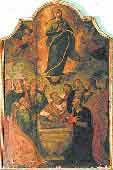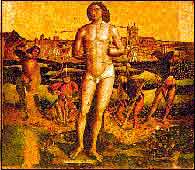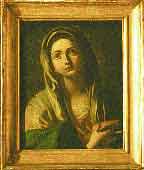
Marble
group of the Lady with Child of the gravestone of Matilde of
Acaia (1332) by T. of Camaino.
|
The
Seminary
was built by the will of cardinal Innico Caracciolo, bishop
of Aversa, between 1711 and 1715, by Roman architect Carlo
Beratti, on the area of the "old castle", beside the
Cathedral.
The
fine façade erected on three levels is inserted among
the northern portale
of the bigtransept of the cathedral and Castello road.
Crossed the entry from the classical portal, on the ligneous
door of the vestibule an interesting clipeato
San
Michele
emerges; the inside of the seminar is characterized by a
harmonious rectangular cloister,
with a double order of harness of which the second, with
false perspective frames, creates tonal effects tonale
mulating Roman surroundings according to Bernini of
Barberini palace. On the left hand a
marble
epigraph
of republican age is walled. On the right the
Scalone
of Onore
we have access to the room of the
Refettorio,
now an auditorium;
in this room the pictorial cycle of the desecrated
Chiesa
of the Carmine,
six cloths and a Cena
in Emmaus
are are kept. The paintings, exalting the Ordine
Carmelitano, constitute an important collection of
paintings.
On
the bottom wall, a Cena
in Emmaus
of a demurian Unknown. The work is inspired to the
compositions of Venetia and, for the strong tonal contrasts,
it comes back to the first decades of the XVIII cent.; on
the left wall, the cloth Madonna'
the bambino and the Santi Carmelitani Angelo and Alberto
from Messina by
Episcopo (1796), afollower of the Stanzione. The painting,
with the soft passages of color, reminds the academic
painting carraccesca.
The
cloth that follows, of an Unknown (end XVIII cent.),
San
Barbara, San Biagio and San
Emidio,
is of demurian style. On the opposite wall, a
Madonna
with Bambino and the Santi hermits Anthonio and Paolo and
Paolo of Tarsus
(Unknown end XVIII sec.). A religious cloth,
Santa
Caterina of Alessandria and Santa
Lucia,
of an unknown author (XVIII-XIX cent.) follows. To these in
the opposite front of the entry, two big cloths, a
Crocifisso
with the Santi Angelo, Carlo Borromeo and Francesco of
Paola
and a Madonna
and Santi in the glory,
both by Nicola Mensele, a painter of Calabrian origin
follower of the school of Solimene follow.
Returning
to the Scalone
of Onore,
realized, maybe, on a sketch of same Beratti, in origin it
presented stairs of grey piperno that better were toned to
the white of the baluster. On the first landing there is the
fine marble group of the Madonna
with the Bambino,
on a Corynthian capital given the bishop of Teano to the
diocese of Aversa; the group, that overtops it, is the only
fragment of the gravestone of Matilde of Acaia, deceased in
Aversa in 1331, made by Tino of Camaino a year later. On the
same wall a portrait
of Cardinal Enrico Caracciolo,
of discrete workmanship, is put.
On
the other walls of the recession of the staircase,
Sant'Andrea,
that is inclined with San
Pietro
(of the adjoining recession). They are works of tasteof
Fracanzano of great plastic vigor. In the
Decapitazione
of Battista,
of an Unknown of the the 600s, ways of late Tuscan mannerism
are recognized. Beautiful and fairy is the figure of
Salomè.
The
following cloth, Madonna
of the Rosario and Santi
Domenicani
is maybe Paolo de Majo that so much has worked in Aversa.
The composition scheme of the end of the sixteenth century
is characteristic of the stories of Maria and
Jesus.
In
the adjoining room besides the already remembered
San
Pietro
there are the Pietà
and Franciscan
Santi,
of an Unknown beginnings of the 700s, in Polo de Majo's
style, and the Madonna
col Bambino, Santa Chiara and other
Santi,
of more solemn execution than the precedent.
As
soon as left the staircase on the right wall there are some
portraits
of eminent men of the seminar: cardinal Innico
Caracciolo,
of an Unknown (second half of 1700), similar to the oval of
the gravestone of the cathedral of Anthonio David.
The second is of cardinal
Francesco Morano,
a pupil of the Seminar, of discrete execution; the third, of
monsignor
Carlo Caputo;
the fourth, of monsignor
Francesco Vento,all
archbishops from Aversa. On the bottom wall of the corridor
is situated a marble
fountain
of the second half of1600 is situated and, on the back, a
marble
sarcophagus with the bust of Christ, of Madonna and San
Giovanni,
half of the XV century.
In
the middle of the corridor, on the right, we have access to
the Cappella
of the Seminario;
the organ
is collocated in the opposite front (end XVIII cent.). On
the right wall, a painted bust of
Madonna
by Andrea Vaccaro and, in front, a
ligneous
Christ
(end '700).
|
|
The
great
hall constitutes
the real gallery of the Seminar. On the right of the entry
there is the painting on table the
Assunzione
of Vergine,
of an Unknown painterof Urbino of the second half of the XV
century. The work that follows, the
Pietà,
is of a great tonal effect (first half 1700), it remembers
the style of Ribera. On on the right wall there is the big
cloth with Madonna
and Santi.
It is a work ofextraordinary beauty for the composition
plant and the hot tone of the colors by Paolo De Matthejs
(1720). On the opposite wall at the entry the painting,
Madonna,
Bambino and the Santi Cornelio and
Biagio
(beginnings XVII century) by Abraham Vinchk.
Going
on we have the cloth of the Deposizione
of Cristo
that follows schemes of the sixteenth century, a probable
copy by Fabrizio Santafede (first years 1600): the colors
and and the shading contrasts are harmonious. The following
painting, by Gerolamo Cenatiempo,
Rinnegazione
of San Pietro
(1724), is of great artistic interest. The
Annunciazione
by Giovanni Angelo Crisconio, of 1597, follows the Flemish
culture. On the left hand, the small cloth of the
Trasfigurazione of 1597, follows the Flemish
culture. On the left hand, the small cloth of the
San
Gerolamo nel deserto,
beginnings of 1700. The work that follows,
Presentazione
of Gesù at the Tempio,
maybe by, goes back to the first half of 1700.
In
this room besides there were two tables by Angiolo Arcuccio,
the Martirio
of San Sebastiano
(1468) and Madonna
with the pomegranate
(both in restauration), of these the first is particularly
important for the presence on the background of the bird
flight outlook of the town of Aversa.
|






